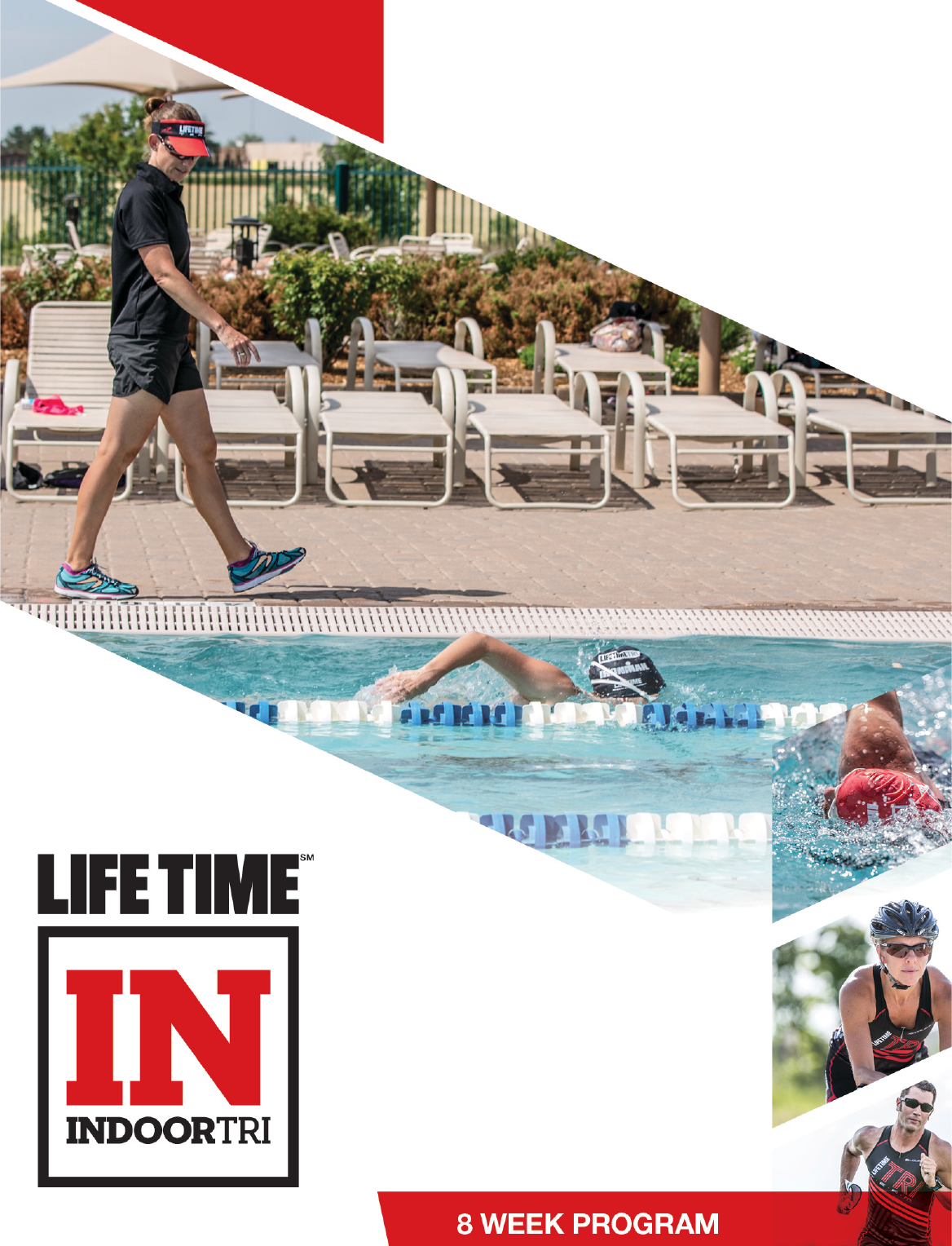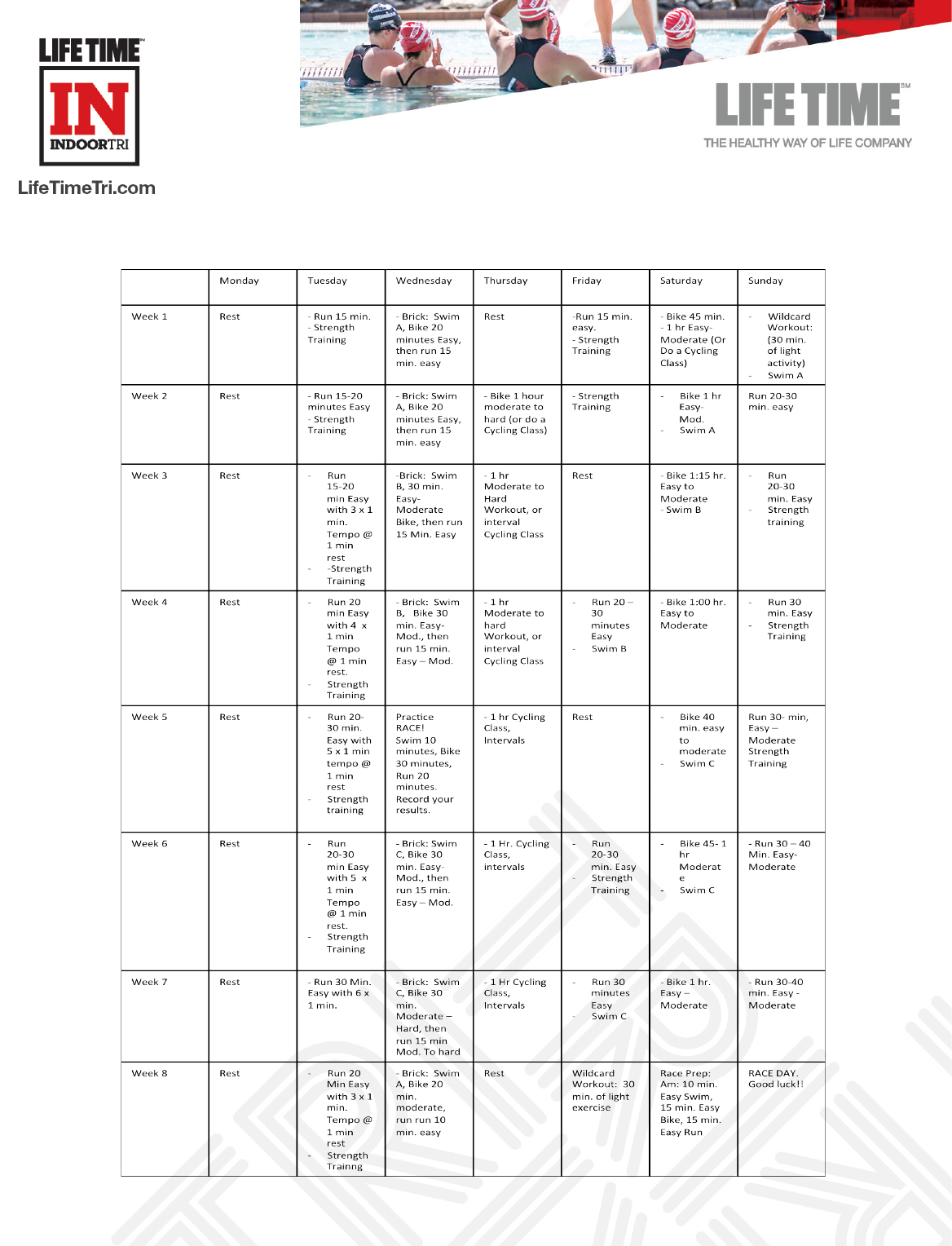
t"
" "

"
!
!
" "
The Official 8-Week Indoor Triathlon Hour Training Program
By Coach Troy Jacobson
Head Coach of Life Time Endurance
www.lifetimeendurance.com
Make a change for the better; #CommitToTri. Embrace a lifestyle of health and fitness.
Spread your wings, and achieve more than you ever thought possible. Redefine your 2016
and become a Triathlete with Life Time INDOOR TRIATHLON HOUR POWERED BY LIFE
TIME TRI AND IRONMAN! www.indoortri.com
Welcome to the Official 8-Week Training Program for Indoor Triathlon Hour Powered by Life Time
Tri and IRONMAN! This program has been designed for the beginner triathlete with minimal
experience in the individual sports of swimming, cycling and running, but with the desire to ‘raise
the bar’. If this describes you, then let’s get started on your journey to becoming a Triathlete!
Indoor Triathlon Hour is a fun and exciting event for athletes of all abilities and offers inspiration
without the intimidation. Whether you are committing to your first triathlon, or you’re an experienced
competitor doing the race as a tune-up or benchmark for the upcoming season, Indoor Triathlon
Hour has something for everyone! Race at your own pace in the company of fellow triathletes,
starting with a 10-minute swim in the indoor pool, followed by a 30 minute bike ride on a stationary
bike, and finishing with a 20-minute run on the treadmill. You’ll have a 10-minute ‘transition’
between the swim and bike legs, and five minutes to move from the bike to the run. At the end of
your race, you’ll have enjoyed a great one-hour full body fitness experience!
GETTING STARTED!
Just like a journey of a thousand miles begins with but a single step, so does the journey in
completing a triathlon. My job, as your coach, is to provide a road map for you to follow, and help
guide you along the way. We’ll start slowly, at a pace that is comfortable for you, but will yield
gradual and long lasting results. Also, we’ll stay focused on the fundamentals… always keeping
your overall health and well being at the forefront of all consideration. After all, the Triathlon
Lifestyle is focused on health and fitness, while having fun with some good natured and productive
competition. The experience will elevate all aspects of your life in a positive manner!

LEARN HOW THINGS WORK
It’s important that you become your own coach during the training process. Knowledge is power! I
encourage you to develop a basic understanding of how the body works, training methodologies,
proper technique, nutrition, and the culture of triathlon training and racing by reading books and
content online from reputable sources. It’s also important that you develop a keen sense of self-
awareness, noting how your body feels and responds to training, changes in diet, and even
recovery modalities. Start a training log, and be consistent with making entries about your training
and how you’re feeling each and everyday.
APPRECIATE THE PROCESS
The saying goes, “Rome wasn’t built in a Day.” Well, the same can be said for becoming a
triathlete! It takes patience and hard work to develop the skills, mental toughness and fitness
necessary to complete a triathlon. The great news about the Indoor Triathlon Hour is that this
particular event is accessible to all, regardless of experience or ability level! The key is to
understand that training is a process, and as with anything in life, the more dedicated to that
process you are, the better your results will be.
WHAT IT TAKES: TIME AND EFFORT
Commit to training almost daily, for approximately one hour. Remember to factor in travel time to
and from workout activities, not to mention your preparation for workouts, like getting dressed for a
swim, or getting your cycling gear ready for a ride.
Also, remember that training for a triathlon takes effort! That means you’re going to sweat, breath
hard, get tired, and feel sore muscles at times. This is all part of the game. The more effort and
time you invest into your training, the better your outcome will be on race day.

DIET MATTERS
When I say ‘diet’, I don’t mean that you’ll go on a ‘diet’. In fact, ‘dieting’, in the traditional sense of
cutting calories, can be counterproductive to reaching your triathlon goals. On the contrary, ‘diet’ in
this context, means to treat food as fuel. Eat a high performance diet of quality proteins, fats and
carbs while reducing (or eliminating) your intake of sweets, refined foods and alcohol, and not only
will you get stronger, you’ll feel much better too. Consider working with a Nutrition Coach at a Life
Time Fitness near you for an individualized nutrition program.
To learn more about nutrition, supplementation, and their impact on your health, download your
free copy of the Life Time Eat Well, Live Well Healthy Way of Life Nutrition Manual. This manual
will help you fuel better for your event, but most importantly, for everyday life.
MONITOR YOUR GAUGES
I already mentioned that endurance athletes need to develop a keen sense of self-awareness, but
let’s take it a step further. It’s imperative that you recognize how training is affecting the way you
feel on a day-to-day basis. While sore muscles are common shortly after a hard training session,
long-term pain and discomfort is not. Use a training log to make notes about how you’re feeling,
and refer to those notes often. If you feel that something is amiss, or if you’re constantly fatigued,
irritable or just ‘blah’, you might be overtraining. If this is the case, make sure you consult with a
coach or other fitness professional to discuss your training plan, and how to make necessary
modifications to it. “Rest” is good for you, and re-energizes the body to perform higher quality
workouts and experience better gains.
Also, before starting this or any exercise program, it is recommended to schedule a complete
physical exam with your physician.
BE SOCIAL
Do you know what’s better than training alone? Training with a group of friends! While racing
triathlon is an individual journey, you’ll find the training journey to be highly social and positively
contagious. Joining a Tri TEAM and training with a group of other like-minded triathletes is the
best way to maintain excitement and consistency with your training. Having a coach who oversees
your workouts helps even more. While some workouts will and should be done solo, consider
joining a local Tri Club or Team for that extra bit of motivation and support.
Also, get the whole family involved. Triathlon is a sport for people of all ages, from young kids to
Senior’s. Engage your family in your training for their support, and you might just get them to the
starting line someday too!

THE RIGHT GEAR
Do you drive a nail with hammer, or with a screwdriver? Having the right tool for the job is
important in the sport of triathlon. For example, quality running shoes that fit your particular foot
size and ground striking technique (i.e. heel or forefoot striker) can greatly enhance your running
comfort, while also preventing injury. Likewise, riding a bike that fits you properly, versus one
that’s too big or too small. At the very beginning of your triathlon career, start off with the right
equipment and apparel for the very best training and racing experience. Work with your coach, or
a local tri-specific retailer, in order to assist you with your equipment needs. Your body is your most
powerful machine; let your gear help ensure you are comfortable and safe while training and
racing.
Here’s a short list of things you’ll need in order to train for Indoor Triathlon Hour:
# Swim Goggles and Swim Suit (or Tri Suit)
# Tri Top
# Cycling or ‘Tri’ shorts (with a pad).
# Cycling shoes are preferred, but not mandatory.
# Run shorts and singlet, or Tri Kit.
# Running Shoes
# Anti Chafe Cream
# Sports Nutrition (Gels, Blocks)
# Water Bottle
# MP3 Player and Earbuds (optional) ‘
# Guts and Determination

“ZONE OUT”
Training intensity is an important factor to consider when it comes to improving fitness for
endurance sports participation. To stay in line with our overlying philosophy of “KISS” (Keep It
Simple, Speedy!). We’ll be using three simple training zones for this program, based on your
‘perceived effort’, including:
Blue Zone: “Easy” training at a conversational and aerobic pace.
Gray Zone: “Moderate” training, pushing the pace slightly into being somewhat uncomfortable.
Red Zone: “Hard” training. Race pace and faster. Pushing into the Hurt Locker!
Of course, you can take your training to the next level by using a heart rate monitor. Knowing
exact Heart Rate training zones can really help you improve at a faster rate, especially as you
become more experienced. Contact your coach or a Metabolic Specialist to learn more, and to
schedule a Metabolic Assessment.
OVERALL CONDITIONING
Ultimately, the triathlon lifestyle should include a well-rounded training program that improves all
aspects of your fitness and health, from cardiovascular conditioning to strength and balance, to
flexibility. And from the standpoint of improving performance, a well-rounded triathlete is usually the
fastest.
An important component of your training program is strength training. While a detailed program is
not in the scope of this general, triathlon specific training program, I nevertheless include days in
which to engage in a strength training routine. Please work with your coach or trainer in order to
build a strength routine suitable to obtaining your individual goals.

" "
SUPPORT
Beginner and experienced athletes alike use a coach to help them reach their potential. A coach
serves the important function of offering guidance, while also providing honest feedback and
support. Furthermore, a coach can assist you with developing and practicing proper form and
technique…very important for the sports of swim/bike/run. Having a coach is like putting a jet
booster pack on your triathlon training and racing learning curve.
At select Life Time Fitness Centers, you can find a Triathlon coach and training programs,
including the Life Time Tri TEAM. You can learn about these options and more by visiting
www.lifetimeendurance.com, or by visiting the Fitness Services Desk at your local Life Time
destination.
INDOOR TRIATHLON HOUR – 8-Week Training Schedule
Instructions: Perform the workouts each day to the best of your ability. Note the ‘Workout Key’
below, describing swim sessions, and other terms. Try to perform weekly ‘brick’ workouts with a
coach, and a training group, for maximum benefit. Rest as needed, and vary the training intensity
and duration per your fitness level. Happy training and good luck!

" "

"
Workout Key:
“Easy” = Blue Zone, light aerobic training. Comfortable.
“Moderate” = Gray Zone, pushing the pace to being slightly comfortable but still able to maintain a
conversation.
“Tempo” = Race pace effort. Challenging but sustainable output.
Swim Workouts:
Tailor the suggested workouts noted below to fit your experience and fitness level. It’s
recommended to seek the help of a coach for explanations of drill work.
Swim A: Warm-up 50yds easy, 4x25 yd drill (catch up) @ 10 sec rest, 4x50 free @ 15 sec. rest,
kick w/ board for 100 yds. Cool-down 50 yds. Easy.
Swim B: Warm-up 100 yds. easy, kick 4x25 fast @ 15 sec. rest, 6 x 25 drill (catch up, finger tip
drag) @ 10 sec rest, 6x 50 tempo @ 20 sec rest, 4x25 kick w/board. Cool-down 100 yds.
Swim C: Warm up 100 yds. easy, 4x50 drill (Catch up, and Finger Tip Drag) @ 10 sec rest, 3x100
tempo @ 30 sec rest, 6 x 25 sprint @ 20 sec rest. Cool-down 100 yds.
